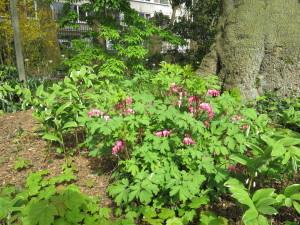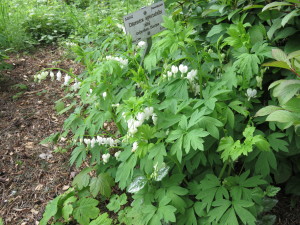Bleeding hearts (Dicentra spp.) are truly one of nature’s glorious delights in the spring garden (USDA hardiness zones 3-9). Old fashion bleeding hearts (D. spectabilis), indigenous to Asia, grow taller and wider compared to their North American counterparts – wild bleeding heart (D. exima) and Dutchman’s breeches (D. cucullaria).
Old fashioned bleeding bear larger (and showier) flowers and their foliage is slightly coarser (less dissected) than their U.S. relatives. All green vegetation generally disappears into summer dormancy unless the planting spot is moist and moderately shady.
The bright red, pink or white, heart-shaped, pendant flowers are supported on arching stems. Old-fashioned bleeding hearts grow 24 inches tall and to 36 inches wide. D. exima plants grow about half the size. Prompt cutting back of the foliage to 4-6 inches immediately following bloom often encourages secondary flowering.
Some cultivars: ‘Alba’ – white-flowering forms of both species; ‘Gold Heart’ – bright chartreuse foliage and pink and white flowers; ‘Valentine’ – a vigorous hybrid form with showy cherry red/white tipped flowers; ‘Luxuriant’ (probably a hybrid between D. eximia (eastern U.S. native) and D. formosa (western U.S. native) – deeply-cut, grayish-green foliage and cherry red blooms.
Good soil drainage is essential for their long term survival. Plant in full to partial shade in a humus-rich, mildly acidic to slightly alkaline (pH range 6.0 to 7.5) soil. In late winter feed a slow-release fertilizer at the low label rate. Bleeding hearts linger in clay-based soils that stays too wet in winter.
Garden centers sell either packaged dormant roots or container-grown plants. Space plants or roots 18-24 inches apart in shade or part shade. Lightly mulch around plants in a woodland garden. Bleeding hearts may self-sow in the garden. In southerly regions plants may die back and become dormant by mid-summer.
Crowded clumps should be divided in spring or fall. Cut pieces of the rhizome with two to four buds (or eyes) each and replant. Divide clumps just after flowering or in very early spring, as growth starts to emerge.
Spring flowers attract butterflies and hummingbirds. Aphids, slugs and snails occasionally feed on the leaves. Plants are deer and rabbit resistant.
Bleeding hearts make great companions with other woodland favorites as ferns, lungworts (Pulmonaria spp.), brunneras, coral bells (Heuchera), and foam flowers (Tiarella).
Note: in recent times the genus Dicentra has been changed to Lamprocapnos.



 Posted in
Posted in 
